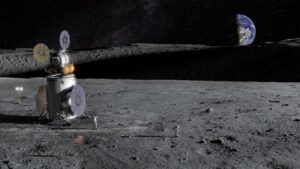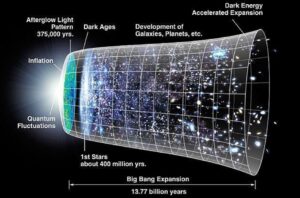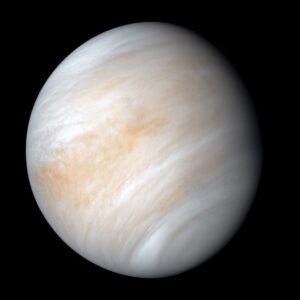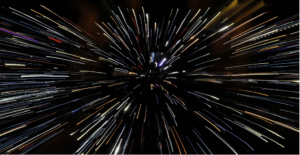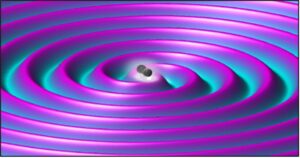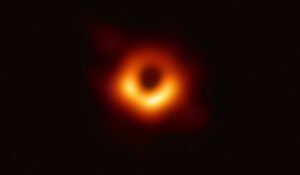
Cover Figure: Simulated timeline of Hubble expansion since the formation of the universe, from the Big Bang to the current day (Wikimedia Commons: Einweichen)
Introduction
Is our current Cosmos made of atomic materials from the collapse of the previous universe? This paper builds up theoretical evidence in favor of this view. It draws from the ‘Big Bounce’ theory, which suggests that the current universe resulted from the collapse of an immediate previous universe (Rankin, 2022).
Ground I: Universal Collapse, The Big Crunch theory
According to John Carl Villanueva (2015), the Big Crunch theory proposes that all the energy in the universe will become evenly distributed over time, preventing any further movement of objects (galaxies, stars, planets, etc.). In layman’s terms, this is referred to as the “heat death of the universe”. First, let’s understand the structure of the universe through the following steps.

Figure 1: An artist’s concept of Gravity Probe B orbiting the Earth to measure space-time, a four-dimensional description of the universe including height, width, length, and time. The earth as seen is exerting mass on spacetime, creating a curvature that is described by the General Theory of Relativity. (Wikimedia commons, Henze NASA)
According to Radiya-Dixit (2017), the universe can be pictured as a four-dimensional Euclidean loop in terms of x, y, and z, which represent the length, width, and height, and t, which represents time.

Figure 2: Demonstration of the 4D Euclidean space-time where x, y, and z represent the distance dimensions (3D), while t represents the time. (Wikimedia Commons: Javier Jose Moreno Tovar18)
The four-dimensional loop can then be visualized as a balloon with components in it. In this case, the “edge” of the universe is the balloon edge, while universal components like black holes and planets within the balloon are pictured as the components.
According to O’Callaghan & May (2021),
Gravity is responsible for pulling the materials together, which in turn increases the momentum and energy of the atoms of constituent objects. This is possible because gravity, as a product of space-time, influences the motion of objects and works to bring them closer to each other. For instance, after an object is thrown up in the air, it accelerates down to earth due to gravity. Likewise, astrophysicists such as Siegel (2020), have observed colliding black holes, which are brought together by gravity and release a massive amount of energy upon colliding.
Dark energy – a theoretical force that works against gravity – is responsible for pushing materials away from each other, thus increasing universal expansion (Kumar, 2013). This in turn reduces atomic energy momentum. A reduction in atomic energy-momentum induces dormancy.
Support for Universal expansion: Hubble expansion
The Hubble expansion began with the Big Bang, and it can be described using the Doppler effect. The Doppler effect describes the phenomenon where the distance of an object from an observer impacts its observed color. The nearer the object, the more blue the object appears, while the further the object, a redder color is observed (BYJU’s, 2019).

Figure 3: Doppler effect as a result of color aberration where objects coming closer towards our relative point of view appear blue whilst those farther away appear red. (Wikimedia Commons: TxAlien)
Current observations show that objects further from the earth appear redder (they are ‘red-shifted’) which indeed suggests they are moving away from our relative point of view, which provides support for universal expansion (European Space Agency, 2019). The force responsible for expansion is scientifically labeled as dark energy as introduced in the preceding paragraph, though scientists still do not fully understand dark energy as they have not observed it directly.
The collapse: Big Crunch

Figure 4: A pictorial representation of the Big Crunch that assumes increased influence of dark matter over the observable universe leading to increased gravitational pull of objects in the universe towards each other, thus the crunch. (Wikimedia commons: Share alike 3.0)
To make strides toward understanding Dark Energy and universal Expansion, scientists have resorted to measuring the density of the universe. When density is higher, so is the gravitational force (Harris, 2009). Scientists believe that there must be a density threshold, critical density, that determines whether gravity is strong enough to halt universal expansion and pull the universe back together. If density exceeds the critical limit, the universe will stop expanding and contract back in. if the density is less than the critical limit, the universe will expand forever. Consider the following equation from Nave (n.d.) that includes the critical density.
Ω = actual average density/critical density
If omega (Ω) is greater than 1, then the universe will halt expansion. If it’s less than 1, the universe will continue expanding. Based on the matter we can observe, such as galaxies, stars, and planets, the actual average density is less than the critical density. Therefore, the universe should expand forever. But cosmologists such as Kumar (2013) think there is another type of matter that should factor into the equation: Dark matter.
Dark matter’s significant influence on the Big Crunch

Figure 5: This collage shows NASA/ESA Hubble Space Telescope images of six different galaxy clusters. The clusters were observed in a study of how dark matter in clusters of galaxies behaves when the clusters collide. 72 large cluster collisions were studied in total. Using visible-light images from Hubble, the team was able to map the post-collision distribution of stars and also of the dark matter as colored in blue (Wikimedia commons: NASA/ESA)

Figure 6: Estimated distribution of dark matter making up 22% of the mass of the universe and dark energy making up 74%, with ‘normal’ matter making up only 0.4% of the mass of the universe (Wikimedia commons: NASA)
First, consider the composition of the universe: Dark energy is thought to make up 73% of the universe, Dark matter up to 23%, and the observable universe the rest (Kumar, 2013). Dark matter and ‘normal matter’ – objects like planets, galaxies, and stars – are pulled towards each other by gravitational force.
This huge chunk of dark matter (23%) within the observable universe influences the Big Crunch theory in the following way as discovered by the Rubin Discovery (n.d): in an observable universe over-burdened by a high density of dark matter, the Hubble expansion that began with the Big Bang continues to decelerate due to the gravitation attraction of the dark matter filling the Universe, ending in a Big Crunch. When the dark matter is taken into account, the average density of the universe is more than the critical threshold, making omega (Ω) greater than one. This would lead the universe contract, though the extent of the contraction is still an active area of research (Specktor, 2022).
The Big Crunch can be thought of in terms of the 4D Euclidean “balloon” mentioned earlier. The balloon reduces in size as the dark matter signifies its dominance over observable matter. However, we note a dark energy paradox to be solved in the next paragraph, which showcases the difficulty in grappling with whether dark energy, is dominant over both the dark matter and ‘normal’ matter. Proponents of the Big Bounce theory believe that dark energy will overcome the power of dark matter and prevent the Big Crunch.
Ground II: Universal Inflation Due to the Big Bounce
Dark Energy’s significant influence in re-initiating a bounce
According to the Rubin Observatory (n.d), in a universe with dark energy as well as dark matter such as ours, an initial deceleration of the universe would be reversed because of the dominance of dark energy. As explained before, dark energy acts against the gravitational force and is assumed to be causing universal expansion. Since dark energy dominates both dark matter and ‘normal’ matter, the 4D Euclidean space can be pictured as “inflating” back from the initial crunch.
Furthermore, it turns out that the concept of loop quantum gravity influences the bounce. This is discussed in the next section, where we consider whether loop quantum gravity works hand in hand with the effects of the dark energy, or if it works in opposition.
Role of Loop Quantum Gravity in the bounce
Once the collapsing universe reaches a specific density that is above the critical density needed for the Big Crunch, a principle called loop quantum gravity will cause the matter and energy to “bounce,” or begin expanding again, creating a new universe. Loop quantum gravity is a principle that seeks to merge quantum mechanics and general relativity. According to the loop quantum gravity theory, as reiterated by Rovelli (1998), there is a limit on which space may shrink, which is up to 1 x 10 ^-35 m, also known as the Planck length.
The more the universe shrinks towards the Planck length, a resistant force holds it back (Rovelli, 1998). Picture the universe as a sponge that is already soaked and saturated with water – it will resist much more water from soaking it. The resistive energy as accommodated within loop quantum gravity causes the Big Bounce.
Furthermore, according to Rovelli (1998), the Big Bounce theory does not reveal if this can (or has) happened once or many times; the crunching and bouncing of the universe could repeat infinitely. Another intriguing possibility is that infinitely repeating universes would be identical, effectively creating a universal time loop. A paradox yet to be settled is what initiated the “first” ever big bang. However, Mathematician Bertrand Russell says: “The idea that things must have a beginning is really due to the poverty of our imagination.” Current research shows a deficiency in solving that paradox.
The Big Bounce theory vs. the big bang singularity theory
The big bang singularity theory suggests the commencement of the universe from a single point in space-time with infinite density and energy (Tereza Pultarova, 2017). According to the Loop quantum gravity theory, space-time volume has a limit of 1×10^-99 cubic cm (Ash, 2018). This volume limit also implies the maximum energy that the universe could attain.

Figure 7: An image showing the possible origin of a universe according to loop quantum cosmology. A transition from the previous universe is described as above representing these concepts : Big Crunch and Big Bounce. (Wikimedia Commons: SteveR2 – Ævar Arnfjörð Bjarmason)
Conclusion and implications
The Big Bounce theory is still under study, fueled by the desire to solve many paradoxes such as the need for an explanation of how the first big bang occurred. The paper also notes the dark energy-loop quantum gravity association paradox during the Big Bounce.
References
Ash, A. (2018, December 26). Loop Quantum Gravity Reveals What Came Before the Big Bang. Www.youtube.com. https://youtu.be/dpmx8D5CXRA
BYJU’s. (2019). Doppler Effect | Wave Motion | JEE Concept | Physics. Byjus.com. https://byjus.com/physics/doppler-effect/
European Space Agency. (2019). What is “red shift”? Esa.int. https://www.esa.int/Science_Exploration/Space_Science/What_is_red_shift
Brandon Specktor published. (2022, May 2). The universe could stop expanding “remarkably soon”, study suggests. Livescience.com. https://www.livescience.com/end-cosmic-expansion
Harris, W. (2009, March 2). How the Big Crunch Theory Works. HowStuffWorks. https://science.howstuffworks.com/dictionary/astronomy-terms/big-crunch.htm#pt5
Kumar, S. (2013, July 24). SnT Blog: Dark-matter made of Dark Atoms? SnT Blog: Dark-Matter Made of Dark Atoms? http://iitk.ac.in/snt/blog/2013/07/24/dark-matter.htm
Nave, R. (n.d.). Density Parameter, Omega. Hyperphysics.phy-Astr.gsu.edu. http://hyperphysics.phy-astr.gsu.edu/hbase/Astro/denpar.html
O’Callaghan, J., & May 2021, H. I. W. magazine 19. (2021, February 21). How does time work? Space.com. https://www.space.com/time-how-it-works
Radiya-Dixit, A. (2017, April 26). Visualizing the Fourth Dimension | Research Blog. Research Blog. https://researchblog.duke.edu/2017/04/26/visualizing-the-fourth-dimension/
Rankin, A. (2022, July 31). What Is the Big Bounce? (with picture). All the Science. https://www.allthescience.org/what-is-the-big-bounce.htm
Rovelli, C. (1998). Loop Quantum Gravity. Living Reviews in Relativity, 1(1), 1. https://doi.org/10.12942/lrr-1998-1
Rubin Observatory. (n.d.). Dark Energy and the Fate of the Universe | Rubin Observatory. Www.lsst.org.
https://www.lsst.org/science/dark-energy/universe#:~:text=In%20a%20universe%20with%20a
Siegel, E. (2020, March 3). Merging Supermassive Black Holes Will Become The Most Energetic Events Of All. Forbes. https://www.forbes.com/sites/startswithabang/2020/03/03/the-most-energetic-event-in-the-universe-hasnt-been-discovered-yet/?sh=34b642213ce8
Tereza Pultarova. (2017, December 5). What If the Big Bang Wasn’t the Beginning? New Study Proposes Alternative. Space.com; Space. https://www.space.com/38982-no-big-bang-bouncing-cosmology-theory.html
Villanueva, J. C. (2015, December 25). Big Crunch – Universe Today. Universe Today. https://www.universetoday.com/37018/big-crunch/
Related Posts
To Infinity and Beyond: Signs of Water on the Moon May Heat up Lunar Exploration
Figure 1: NASA’s Artemis program has the goal of putting the...
Read MoreAlternative Proposal to the Big Bang’s Singularity Theory: the Hartle-hawking State
Cover: A simulated timeline of the events since the big...
Read MorePossible Biosignature for Life Discovered on Venus
Figure 1: This is an image of Venus with its...
Read MoreThe Unruh Effect: Newly Proposed Experiment Aims to Detect Vacuum Radiation Due to Acceleration
Figure 1: The Unruh effect states that for an accelerating...
Read MoreDetecting Gravitational Waves with Precision: Evolution of Gravitational Wave Detectors
Figure 1: Simulated model of spacetime ripples as a result...
Read MorePrimordial Black Holes: The Key to Dark Matter?
Figure 1: The first picture of a blackhole Source: Wikimedia...
Read MoreFrankline Misango Oyolo

